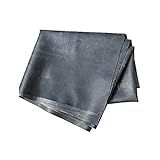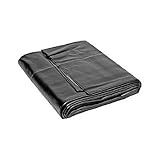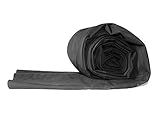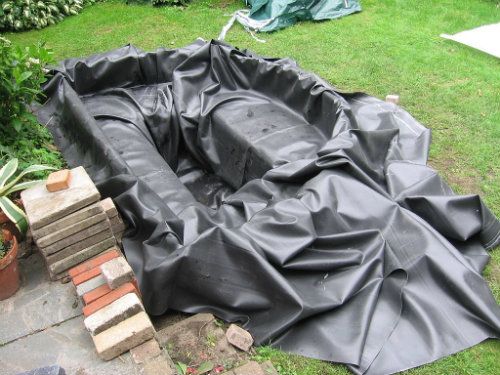Best EPDM Liners to Buy in January 2026

10 x 15 Firestone 45 Mil EPDM Pond Liner
-
20-YEAR WARRANTY: ENJOY PEACE OF MIND WITH OUR RELIABLE LONG-TERM GUARANTEE.
-
SUPERIOR DURABILITY: TEAR AND PUNCTURE-RESISTANT FOR LASTING PERFORMANCE.
-
FISH SAFE: SPECIALLY FORMULATED FOR SAFE USE WITH AQUATIC LIFE.



VEVOR 20 x 25 ft Pond Liner, 45 Mil Thickness, Pliable & Durable EPDM Material, Easy Cutting Underlayment for Fish or Koi,Waterfall, Fountains, Water Gardens, Black
- SECURE FISH ENVIRONMENT: PREVENT CONTAMINATION, ENHANCE FISH HABITAT!
- DURABLE & PUNCTURE-PROOF: 45 MIL THICK FOR LONG-LASTING POND PROTECTION.
- FLEXIBLE INSTALLATION: EASILY FITS ANY POND SHAPE; NO TOOLS REQUIRED!



Firestone 45mil EPDM Rubber Pond Liner 15ft.x20ft.
- FLEXIBLE DESIGN FOR UNIQUE POND CREATIONS.
- ECO-FRIENDLY AND SAFE FOR FISH HABITATS.
- DURABLE, LOW-MAINTENANCE BEAUTY FOR LASTING APPEAL.



Lifeguard 15 ft. x 15 ft. EPDM Pond Liner – 45-Mil Rubber Liner for Outdoor Ponds, Waterfalls, Aquaponics, Retention Basins – Durable & Fish Safe
- DURABLE EPDM LINER: UV & PUNCTURE RESISTANT FOR LASTING PONDS.
- SAFE FOR MARINE LIFE: CERTIFIED FOR KOI, TURTLES, AND AQUATIC ECOSYSTEMS.
- EASY DIY INSTALLATION: FLEXIBLE DESIGN CONFORMS TO ANY POND SHAPE.



15 x 20 Firestone 45 Mil EPDM Pond Liner
- OZONE RESISTANT FOR LONG-LASTING OUTDOOR DURABILITY.
- RESISTS BLISTERING, CRACKING, AND SUN DETERIORATION.
- TOUGH 45 MIL EPDM RUBBER ENSURES SUPERIOR FLEXIBILITY.



Firestone PondGard 45 Mil 20 x 25-Feet EPDM Pond Liner
- 20-YEAR WARRANTY: LONG-LASTING DURABILITY AND PEACE OF MIND.
- ECO-FRIENDLY: SAFE FOR FISH & PLANTS, SUPPORTING A HEALTHY ECOSYSTEM.
- 75-YEAR LIFE: RELIABLE, LONG-TERM INVESTMENT FOR YOUR PROJECTS.


It’s no secret that we prefer liners to preformed shells. We’ll order them if you insist but we won’t clutter our store with something we don’t believe in.
- Liners allow you to be more creative with the shape of your pond. You must conform to the manufacturer’s idea of the perfect pond if you use a preformed shell.
- None that I know of come in three feet depths - a must if you want to offer your fish protection from predators.
- It saves you no time to put a preformed pond into the ground. In fact, it costs you another step to backfill to fit the shape of the shell.
- You can’t put maintenance-saving bottom drains in the hard plastic shells.
- When the ground shifts (as it often does) the form will shift with it and your carefully constructed leveling job will be for aught.
- Forget putting that beautiful large boulder on the lip of the preformed shell. It will crack under the weight.
- And when it cracks let us know if the patching material stays on for more than a month.
If I’ve steered you away from purchasing that seemingly “easy to install” preformed pond shell - good! Now you need to decide what kind of liner to install. We have our preferences on that too!
As far as we’re concerned, there is no choice. The EPDM 45 mil rubber liner material is the only liner we carry. Oh, we could carry them all - in fact we did the first year we were open. We found problems with all the others and simply chose not to deal with any more problems than we had to. This was the same philosophy we used when we chose what brands of pumps to carry, but that’s another story…
If someone offers you an irresistible deal on 45 mil EPDM - resist it. We have seen where folks are selling 45 mil EPDM rubber liner material for CHEAP prices and found out that it’s used by roofers and has been treated with some kind of chemical (can’t remember the name) that is very toxic to fish. Be sure the material is fish safe.
45 mil EPDM is thick and it’s pretty heavy. We don’t recommend the 65 mil EPDM with attached underlayment. It’s the devil to work with and if you have to fold it in the corners, etc. (and most of us do) the folds are quite ugly and bulky. It’s best to install separate underlayment.
Steer away from Permalon. It’s possible that someone has told you that Permalon is the best liner for a number of reasons. Like I stated earlier, we have carried it and found problems with it! It’s plastic. It has ridges that do not allow for easy patching if you get a tear in it - which you probably will because the liner is not as thick and durable as EPDM rubber. It is known to have problems where the seams are glued. It’s stiff and very hard to work with and it’s easy to puncture. If someone does tell you that Permalon is the best thing since sliced bread beware. It could be that the manufacture gives excellent pricing incentives to the dealer.
Let’s not dwell on negatives and switch back to the virtues of 45 mil EPDM rubber liner. It comes in a wide selection of widths. We keep the following widths in stock: 5.5 ft. / 10 ft. / 15 ft. / 20 ft. / 25 ft. / and 30 ft. Larger widths are readily available for special order. Widths become very important when you’re paying by square foot.
45 mil EPDM forgives. If you don’t get it tucked “just right” into the corner of your hole the rubber stretches with the pressure of the water against the pond wall and fills the void.
EPDM carries a 20-year warranty. Because it is thick it is also very heavy. That could be the only negative about it! It’s well worth the extra labor to install.
The liner is the skin of your pond and will be around for a very long time. Don’t cost yourself trouble, money and aggravation by trying to find a “deal” on this particular product. After all, what good is a liner that doesn’t hold water?
